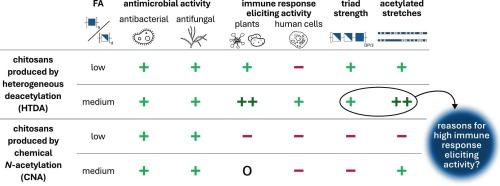Chitosan production methods influence receptor-mediated immune responses but not target-mediated antimicrobial bioactivities
IF 12.5
1区 化学
Q1 CHEMISTRY, APPLIED
引用次数: 0
Abstract
Chitosans are promising polysaccharides for the growing bioeconomy, but their numerous bioactivities depend on their structural parameters. Whereas researchers are currently unraveling the influence of the degree of polymerization and the fraction and pattern of acetylation on the properties and activities of chitosans, the role of their production method has received little attention so far. In this study, we show that polymers produced by heterogeneous deacetylation (HTDA) trigger significantly higher immune responses in plants and human cells compared to chemically N-acetylated (CNA) chitosans. This may be due to a higher abundance of acetylated stretches in combination with a more regular pattern in the HTDA samples as opposed to more uniform CNA polymers with random acetylation patterns. In contrast to the receptor-mediated immune responses, antimicrobial bioactivities, which are rather target- than receptor-mediated, were not affected by the production method. The results are of great interest for chitosan research and applications in fields such as agriculture or biomedicine, where scientists should be imperatively aware of the differences between HTDA and CNA chitosans. For instance, the eliciting activities of HTDA chitosans in plants might be preferable for crop protection, while the low immune response to CNA chitosans could be desirable for biomedical applications.

壳聚糖的生产方法影响受体介导的免疫反应,但不影响靶向介导的抗菌生物活性
壳聚糖是一种很有前途的多糖,在不断发展的生物经济中,但其众多的生物活性取决于其结构参数。尽管研究人员目前正在揭示聚合程度和乙酰化的比例和模式对壳聚糖性质和活性的影响,但它们的生产方法的作用迄今为止很少受到关注。在这项研究中,我们发现,与化学n -乙酰化(CNA)壳聚糖相比,由非均相去乙酰化(HTDA)产生的聚合物在植物和人类细胞中引发了更高的免疫反应。这可能是由于HTDA样品中乙酰化延伸的丰度更高,且模式更规则,而不是更均匀的具有随机乙酰化模式的CNA聚合物。与受体介导的免疫应答相反,抗菌生物活性,而不是受体介导的,不受生产方法的影响。这些结果对壳聚糖在农业或生物医学等领域的研究和应用具有重要意义,科学家们应该迫切地了解HTDA和CNA壳聚糖之间的差异。例如,HTDA壳聚糖在植物中的诱导活性可能更适合用于作物保护,而对CNA壳聚糖的低免疫反应可能更适合用于生物医学应用。
本文章由计算机程序翻译,如有差异,请以英文原文为准。
求助全文
约1分钟内获得全文
求助全文
来源期刊

Carbohydrate Polymers
化学-高分子科学
CiteScore
22.40
自引率
8.00%
发文量
1286
审稿时长
47 days
期刊介绍:
Carbohydrate Polymers stands as a prominent journal in the glycoscience field, dedicated to exploring and harnessing the potential of polysaccharides with applications spanning bioenergy, bioplastics, biomaterials, biorefining, chemistry, drug delivery, food, health, nanotechnology, packaging, paper, pharmaceuticals, medicine, oil recovery, textiles, tissue engineering, wood, and various aspects of glycoscience.
The journal emphasizes the central role of well-characterized carbohydrate polymers, highlighting their significance as the primary focus rather than a peripheral topic. Each paper must prominently feature at least one named carbohydrate polymer, evident in both citation and title, with a commitment to innovative research that advances scientific knowledge.
 求助内容:
求助内容: 应助结果提醒方式:
应助结果提醒方式:


